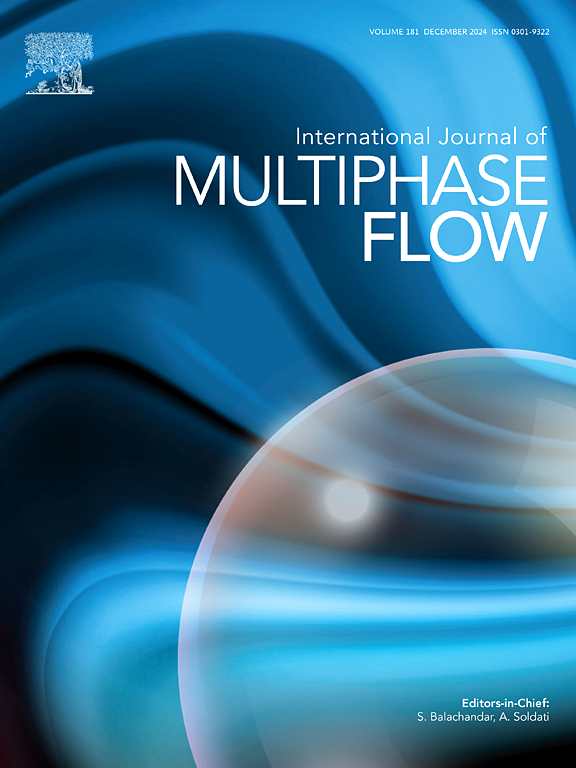剪切减薄对微通道中滴-喷过渡和液滴尺寸调节的影响
IF 3.8
2区 工程技术
Q1 MECHANICS
International Journal of Multiphase Flow
Pub Date : 2025-09-19
DOI:10.1016/j.ijmultiphaseflow.2025.105459
引用次数: 0
摘要
在与微液滴相关的材料或器件制造领域,流体的流变特性是影响微液滴应用的关键因素。基于实验和界面动力学理论,研究了剪切减薄效应对微滴运动和变形的控制作用。总结了液滴形成机制的流型图,并与牛顿流体的流型图进行了比较,表明剪切变稀流体更容易形成单分散液滴,同时延迟了滴向喷射的转变。在滴落过程中,剪切引起的分散相等效粘度的降低加速了颈部破碎过程,提高了液滴分离效率。相反,在喷射过程中,分散相粘滞力占主导地位,这决定了界面的稳定性。结合高速显微粒子图像测速(µPIV)技术和界面跟踪技术,定量分析了瞬态速度梯度和剪切速率分布。揭示了剪切减薄行为对界面破裂过程的影响。通过定义特征剪切速率和等效粘度,建立了液滴粒径尺度规律的经验表达式,为精确调控微液滴提供了理论依据。研究结果进一步丰富了复杂流体的微尺度流动理论,揭示了剪切减薄流体的机理,有助于推动剪切减薄流体在能源、生物医学等诸多领域的应用和发展。本文章由计算机程序翻译,如有差异,请以英文原文为准。

Shear-thinning effects on dripping-to-jetting transition and droplet size regulation in a microchannel
In the field of microdroplet-related material or device fabrication, the rheological properties of fluids constitute a critical factor influencing the applications of microdroplets. In this study, the role of shear-thinning effect in governing the motion and deformation of microdroplets are investigated based on experiments and interfacial dynamics theory. The flow pattern maps of droplet formation regimes are summarized, and compared with that of the Newtonian fluid, indicating shear-thinning fluids are more likely to form monodisperse droplets while delaying the dripping-to-jetting transition. In dripping, shear-induced reduction of the dispersed phase equivalent viscosity accelerates the neck breakup process, improving the droplet detachment efficiency. Conversely, in jetting, the dominance shifts to the dispersed phase viscous force, which determines the interface stabilization. Combined with high-speed microscopic particle image velocimetry (µPIV) technology and interfacial tracking technique, the transient velocity gradients and shear rate distributions are quantitatively analyzed. The influences of the shear-thinning behavior on interfacial rupture processes are revealed. By defining characteristic shear rates and the equivalent viscosity, an empirical expression of the scaling law for droplet size is established, providing a theoretical basis for precise microdroplet regulation. The results further enrich the microscale flow theory of complex fluids, and the revealed mechanisms help promote the application and development of shear-thinning fluids in many fields such as energy and biomedicine.
求助全文
通过发布文献求助,成功后即可免费获取论文全文。
去求助
来源期刊
CiteScore
7.30
自引率
10.50%
发文量
244
审稿时长
4 months
期刊介绍:
The International Journal of Multiphase Flow publishes analytical, numerical and experimental articles of lasting interest. The scope of the journal includes all aspects of mass, momentum and energy exchange phenomena among different phases such as occur in disperse flows, gas–liquid and liquid–liquid flows, flows in porous media, boiling, granular flows and others.
The journal publishes full papers, brief communications and conference announcements.

 求助内容:
求助内容: 应助结果提醒方式:
应助结果提醒方式:


